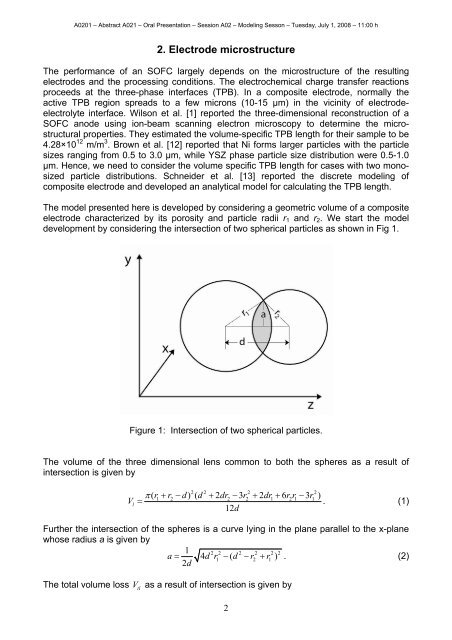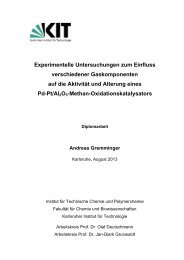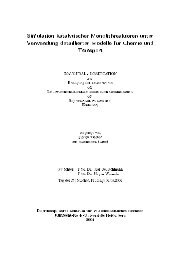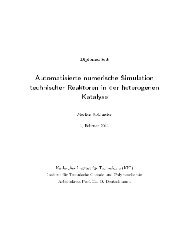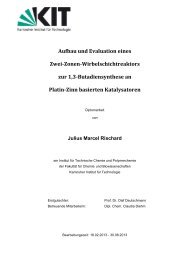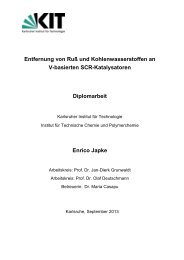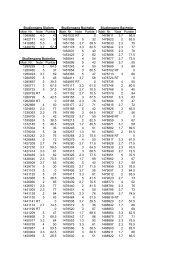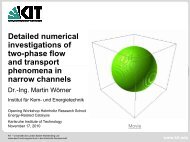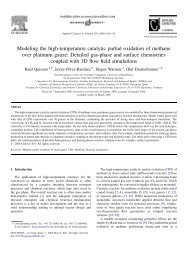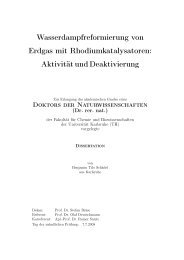SOFC Modeling - From Micro-Kinetics to Stacks - KIT
SOFC Modeling - From Micro-Kinetics to Stacks - KIT
SOFC Modeling - From Micro-Kinetics to Stacks - KIT
Create successful ePaper yourself
Turn your PDF publications into a flip-book with our unique Google optimized e-Paper software.
A0201 – Abstract A021 – Oral Presentation – Session A02 – <strong>Modeling</strong> Sesson – Tuesday, July 1, 2008 – 11:00 h<br />
2. Electrode microstructure<br />
The performance of an <strong>SOFC</strong> largely depends on the microstructure of the resulting<br />
electrodes and the processing conditions. The electrochemical charge transfer reactions<br />
proceeds at the three-phase interfaces (TPB). In a composite electrode, normally the<br />
active TPB region spreads <strong>to</strong> a few microns (10-15 µm) in the vicinity of electrodeelectrolyte<br />
interface. Wilson et al. [1] reported the three-dimensional reconstruction of a<br />
<strong>SOFC</strong> anode using ion-beam scanning electron microscopy <strong>to</strong> determine the microstructural<br />
properties. They estimated the volume-specific TPB length for their sample <strong>to</strong> be<br />
4.28×10 12 m/m 3 . Brown et al. [12] reported that Ni forms larger particles with the particle<br />
sizes ranging from 0.5 <strong>to</strong> 3.0 μm, while YSZ phase particle size distribution were 0.5-1.0<br />
μm. Hence, we need <strong>to</strong> consider the volume specific TPB length for cases with two monosized<br />
particle distributions. Schneider et al. [13] reported the discrete modeling of<br />
composite electrode and developed an analytical model for calculating the TPB length.<br />
The model presented here is developed by considering a geometric volume of a composite<br />
electrode characterized by its porosity and particle radii r 1 and r 2 . We start the model<br />
development by considering the intersection of two spherical particles as shown in Fig 1.<br />
Figure 1: Intersection of two spherical particles.<br />
The volume of the three dimensional lens common <strong>to</strong> both the spheres as a result of<br />
intersection is given by<br />
V<br />
l<br />
2 2 2 2<br />
π ( r1+ r2 − d) ( d + 2dr2 − 3r2 + 2dr1+ 6rr 2 1−3 r1<br />
)<br />
= . (1)<br />
12d<br />
Further the intersection of the spheres is a curve lying in the plane parallel <strong>to</strong> the x-plane<br />
whose radius a is given by<br />
1 2 2 2 2 2 2<br />
a= 4 d r1 −( d − r2 + r1<br />
) . (2)<br />
2d<br />
The <strong>to</strong>tal volume loss V<br />
tl<br />
as a result of intersection is given by<br />
2


